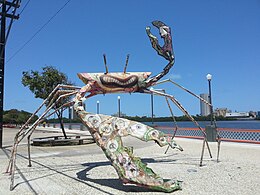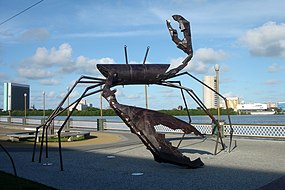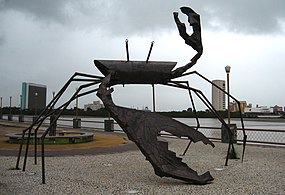
The music of Brazil encompasses various regional musical styles influenced by European, American, African and Amerindian forms. Brazilian music developed some unique and original styles such as forró, repente, coco de roda, axé, sertanejo, samba, bossa nova, MPB, gaucho music, pagode, tropicália, choro, maracatu, embolada, frevo, brega, modinha and Brazilian versions of foreign musical styles, such as rock, pop music, soul, hip-hop, disco music, country music, ambient, industrial and psychedelic music, rap, classical music, fado, and gospel.

Francisco de Assis França, better known as Chico Science, was a Brazilian singer and composer and one of the founders of the manguebeat cultural movement. He died in a car accident in 1997 in Recife, Pernambuco, at the age of 30.

Nação Zumbi is a Brazilian band formed by Chico Science. They have been hailed as one of the most important groups to come out of the manguebeat movement in the 1990s. The musicians of the group continued as Nação Zumbi after Science died in a car accident on February 2, 1997.

Fred Rodrigues Montenegro, known by the stage name Fred 04, is the leader, singer, guitarist and cavaquinho player of Brazilian band Mundo Livre S/A. He is the co-author, along with DJ Renato L, of the Mangue Bit manifesto, "Caranguejos Com Cérebros". He has a degree in journalism from the Federal University of Pernambuco. He made up his nickname '04' after the two last digits in his identity document.

The term maracatu denotes any of several performance genres found in Pernambuco, Northeastern Brazil. Main types of maracatu include maracatu nação and maracatu rural.
Brazilian rock refers to rock music produced in Brazil and usually sung in Portuguese. In the 1960s, it was known as iê-iê-iê, the Portuguese transcription of the line "Yeah, yeah, yeah" from the Beatles song "She Loves You".

MTV Brasil was a Brazilian over-the-air television network owned by Grupo Abril focused on the youth and entertainment. The network was launched on 20 October 1990, as the first specialty television network to broadcast over-the-air, becoming the local version of MTV. It was the third MTV iteration launched in the world, and the first to broadcast via terrestrial television.
Cordel do Fogo Encantado is a Brazilian band from Arcoverde who mix different Brazilian musical genres, such as samba de côco, toré indígena, embolada, and reisado, with pop-rock melodies. The band derives its name from cordel, a type of handmade illustrated pamphlet literature made by woodcut artists in northeastern Brazil. Cordel do Fogo Encantado is associated with Pernambuco's Mangue Beat, a musical movement that is repopularizing traditional northeastern Brazilian folkloric musical genres by mixing them with rock and funk music.
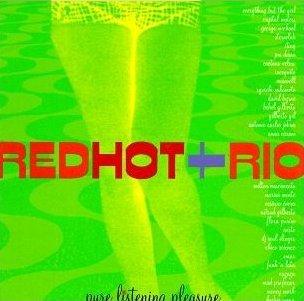
Red Hot + Rio is a compilation album produced by Béco Dranoff and Paul Heck as part of the Red Hot AIDS Benefit Series intended to promote AIDS awareness. This installment is a contemporary tribute to the bossa nova sound, especially the music of Antonio Carlos Jobim. This release has proven to be one of the Red Hot series' more successful projects, generating hundreds of thousands of dollars for AIDS charities around the world.
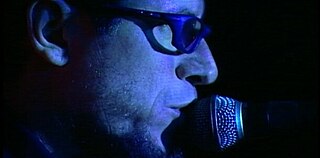
Mundo Livre S/A is a Brazilian mangue bit band, formed in 1984 in Recife, Pernambuco. It is also one of the founders of that musical style, which became popular in the 1990s. Fred Zero Quatro, the band's singer, was one of the authors of Caranguejos com Cérebro, one of the landmarks of the Manguebeat movement, together with Renato L. and Chico Science.
Virgínia Rodrigues is a Brazilian singer. Her music has an influence of classical music, samba, and jazz, and her lyrics reference Candomblé and Umbanda entities.

Sérgio Cassiano is a Brazilian jazz composer, percussionist, writer, producer, and bandleader.

Da Lama ao Caos is the debut album by the Brazilian band Chico Science & Nação Zumbi. Released in 1994, the album presents a fusion of funk rock and maracatu and contributed for spreading the music of Pernambuco around the world. Da Lama ao Caos is considered the manifesto of the Manguebeat movement.
Béco Dranoff is a Brazilian-American music producer and creative Brazilian music events and film producer and co-founder of the Ziriguiboom Discos music label.

Tieta of Agreste is a 1996 Brazilian comedy film directed by Carlos Diegues. It is based on the novel Tieta by Jorge Amado. The film was selected as the Brazilian entry for the Best Foreign Language Film at the 69th Academy Awards, but was not accepted as a nominee.
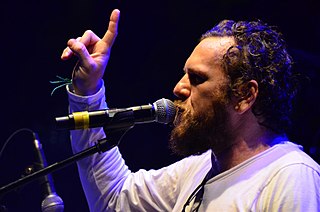
Otto Maximiliano Pereira de Cordeiro Ferreira, known mononymously as Otto, is a Brazilian singer-songwriter, drummer, and television actor and presenter, famous for being one of the founding members of the pioneering Mangue Bit band Mundo Livre S/A, of which he served as its drummer from 1984 to 1996.
Nélson Jacobina Rocha Pires was a Brazilian lyricist, songwriter and guitarist, famous for his enduring partnership with fellow musician Jorge Mautner, with whom he wrote, among many other songs, the 1974 hit "Maracatu Atômico".
"Maracatu Atômico" is a song written and composed by Brazilian musicians Jorge Mautner and Nélson Jacobina in 1974, and originally performed by Mautner on his self-titled album released in the same year. It is one of the duo's most famous creative outputs, thanks to the numerous cover versions it received over the years, the most famous of them being the one made by Nação Zumbi in 1996.

Jorge Du Peixe, stage name Jorge José Carneiro de Lira, is a Brazilian singer-songwriter.

Maracatu Nação, also known as Maracatu de Baque Virado, is a type of maracatu, a musical rhythm, dance and ritual of religious syncretism that originated in the state of Pernambuco. It is the oldest Afro-Brazilian rhythm.
